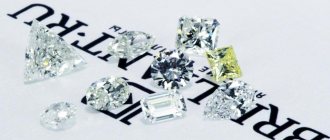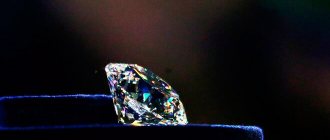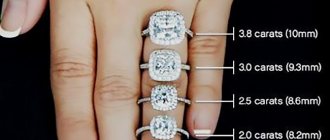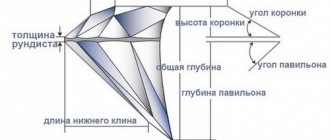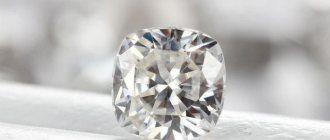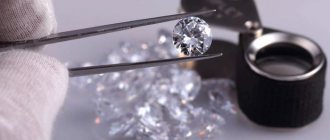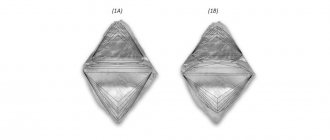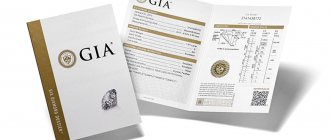The ability to decipher the characteristics of diamonds recorded on a special tag will help you learn about the characteristics of the jewelry. They tell you about the diamond's carat weight, color, clarity, presence of defects, and shine in the sun. The cost of a stone directly depends on these indicators, and the ability to navigate the presented numbers and letters will protect you from unnecessary financial expenses.
Rating according to the 4 “C” system
Diamonds formed in the natural environment are not a homogeneous crystalline mass. Before cutting, they have invisible and visible to the naked eye cracks, air bubbles or foreign inclusions.
This affects the color and transparency of the diamonds obtained after cutting, which are sold in jewelry stores or go under the hammer at world-famous auctions.
In Russia, as in the rest of the world, the 4 “C” rating system is used. It allows you to describe a gemstone in detail using its physical characteristics. These include:
- cut
- carat weight;
- color (color);
- diamond purity (clarity).
Read more about this in the article “Evaluation of diamonds by clarity and other parameters.”
If several precious stones are used in the manufacture of jewelry, then their exact number will be indicated on a special tag.
Diamond is different from diamond. How to decipher a tag on a product
In the jewelry industry, such a specialized specialist as a gemologist is highly valued. There are few such experts in Belarus. A gemologist can easily determine the type of gemstone and its origin, and distinguish chemical analogues and imitations from natural gemstones. But a basic minimum of knowledge when reading the tag on a piece of diamond jewelry will be useful to every consumer. Vladimir GALKOVSKY, a jeweler and expert in restoration, repair and production of jewelry, helped to understand this issue
QUALITY CONTROL
— Prices for diamond jewelry depend on the quality of the gemstone, assessed by a number of its properties, since the difference between two stones of the same weight can be significant. The rating of diamonds is based on four parameters - Carat (weight), Color (color), Clarity (transparency), Cut (cut quality). This classification is called “4C”.
The weight of a diamond is measured in carats. 1 carat is equal to 0.2 grams. There are three groups of diamonds: small, medium and large. The weight of small stones is up to 0.29 carats, medium diamonds vary between 0.3 and 0.99 carats. Stones larger than 1 carat are considered large. For greater clarity, let's give a carat to millimeter: 4 mm is 0.25 carats; 5.5 mm – 0.5 carats; 6.5 mm – 1 carat. At first glance, the difference in millimeters is tiny, but visually it is noticeable.
Diamonds are divided into groups based on color: traditional and fancy. The first group includes colorless gemstones and the entire color scale with a gradual increase in gray, brown, and yellow shades. The most valuable are “diamonds of pure water”, that is, colorless. There is a simple test to determine colorlessness: the stone being tested should not be visible in a glass of water. The least valuable are stones with a strong yellow color. The second group includes green, red, blue, pink, blue, cognac, yellow diamonds, etc. Unlike white diamonds, which are relatively abundant in nature, colored diamonds are very scarce and their supply is decreasing. The natural fancy color of a diamond occurs due to mineral impurities during the formation process, changes in the crystal lattice, or under the influence of other factors. For example, an admixture of manganese forms a pink color, iron - brown, chromium particles - green. The color of a diamond can vary from 1 - colorless to 12 - black diamonds. The lower the number, the better the color, and therefore the more expensive the stone. It is often difficult for a buyer to distinguish between the first and third colors of a stone, since they are distinguished by a slight shade of gray, yellow, or brown. And the difference in price is significant. I do not recommend buying a stone with a characteristic higher than 4. Here I would like to note the following: stones up to 0.3 carats with a characteristic of 5/5 are considered to be of lower quality than stones with the same characteristics, but larger than 0.3 carats. And a stone from 0.6 to 1 carat is considered good.
Clarity is the main quality parameter for diamonds. It is expressed in the presence or absence of defects and foreign inclusions in the stone. The purity of the stone is determined from quality 1 without visible defects to quality 9 with visible defects. Defects include chips, bubbles, and carbon inclusions. In small stones, it is impossible to distinguish the 1st quality from the 3rd without special magnifying devices.
In assessing a cut, the quality of the workmanship plays a significant role, not the shape. There are such shapes as heart, emerald, marquise, asscher, pear; they correspond to the abbreviations CE, I, M, A, G. The play of light and brilliance depend on the geometry, number of faces and proportional accuracy of the cut. The number of edges is added to the letter designation of the shape. For example, CE-57 is a heart with 57 sides. Sometimes information on the quality of the cut is added. The highest quality cut is designated by the letter “A”, then “B”, “C”, “D” in descending order.
READ THE TAGS ON THE PRODUCT
— When buying diamond jewelry, the question arises: what do the letters and numbers indicated on the jewelry’s paper tag mean? Typically, such a label contains the following information: manufacturer, name of the jewelry, article number, name of the precious metal and purity, weight of the product, quality characteristics of the diamonds, their size, quality control stamp. The sample indicates the composition of the metal, that is, the percentage of pure gold. On the tag, the parameters of the diamond are indicated next to the word “Insert”. Let's give an example: Br. I-57 B – 3 pcs. 3/2 0.11 ct. The transcript of the entry is as follows: a diamond cut in the shape of an emerald has 57 facets (the optimal type of cut for refraction of light rays and their reflection), cut quality B with a small defect that does not affect the characteristics of the stone, for example, the proportion of the stone is distorted or an unpolished crack is painted over, the number of stones is 3 pieces, the total weight of stones in the product is 0.11 carats. In the quality parameter 3/2: the number 3 is a subtle gray, yellow or brown tint in small stones; and the number 2 indicates that these are stones of second quality, that is, without visible defects that can be seen with the help of special magnifying devices.
How to read the tag
Let’s imagine that you are planning to buy a piece of jewelry whose tag in the “Inserts” section says 3Br-Kr57–0.2ct–3/6A. It looks like a complex formula, but such a record is very easy to decipher.
The first value “3Br” indicates that 3 diamonds are inserted into the product.
“Kr57” indicates the type of cut. In our case, the cut is round, and each stone has 57 facets or facets.
Diamonds with a round cut type are most often encrusted with products with a large number of small precious stones (up to 1 carat).
Large minerals are cut in other types, among which the following stand out:
- "Marquis" with 55 facets "M55";
- "Princess" P49, "P65", P68";
- “Pear” - “G55 and “G56”;
- “Round” - “Kr57”, “Kr17”, “Kr33”;
- "Oval" - "O57";
- “Emerald” - “I57” and “I65”;
- “Asher” - “A25”, “A49”, “A55”;
- "Radiant" - "P65", "P70";
- “Heart” - “C57”, “C58”;
- “Trilliant” or “Trillion” “T19”, “T31”, “T37”, “T52”.
“0.2ct” means that the total weight of stones of the same size and the same cut is 0.2ct. If diamonds of different sizes and qualities are inserted into the product, then there are several entries on the tag corresponding to each of them.
Weight and cut type play a big role, but much more important is the color and clarity of the diamond, as well as the quality of the cut, which you must be able to correctly decipher.
How to choose a diamond ring if you haven't already.
Each piece of jewelry is given a personal tag that indicates the characteristics of the stone, metal alloy, carat value, clarity of the stone and the manufacturer of the jewelry.
Let's take a look at the characteristics of the stone:
1 Br Kr-57-0.52 3/4 A
2 Br. G-56-0.53 4/4 C
First, let's decipher the first line:
- [1] — the number of stones of the specified size group and characteristics.
- [Kr-57] - description of the cut, in this case the standard diamond cut is round fifty seven-sided.
- [0.52] is the weight of the diamond in carats.
- [3/4] - the first number indicates the color group, the second - the purity group. For stones over 0.3 carats, the color scale has gradations from 1 to 9, the quality scale from 1 to 12. The best characteristic is 1.
- [A] – quality group of proportions. The proportions of a round diamond are divided into groups from A to D. The best is group A.
Thus, the first line of the entry can be read as follows: one round-cut diamond with 57 facets, weighing 0.52 carats, with color characteristics 3 (good color), quality 4 (fairly good characteristics) is inserted into the product.
Try reading the second characteristic yourself. If you succeeded, congratulations, you are almost a gemologist - you already know how to read jewelry tags and easily understand the quality of the stone in front of you.
When inspecting the jewelry, you should pay attention to the following things:
It is mandatory to have a hallmark or hallmark on the inside of the ring.
The state hallmark is a guarantee mark applied to confirm quality, proof that the fineness of the metal is not lower than that indicated in the hallmark. The state hallmark includes a name mark (the mark of a company or a craftsman), as well as an identification mark, an assay mark, and a GIPN code, which can be affixed both together (in one outline) and separately.
In the same way, the manufacturer’s mark is applied to the ring, which must match the logo on the product tag. You can also send a request to the manufacturer asking them to confirm the authenticity of the ring.
Now you are familiar with some of the basic elements needed when buying a ring, you can begin to make a choice that is sure to please your significant other.
If you are still wondering where you should buy a diamond ring so as not to go wrong, you should definitely check out our collections. Jewelry is the largest manufacturer in the Northwestern Federal District. By choosing our products, you will join the club of owners of unique, modern, high-quality jewelry that will become a treasure for your family.
Luster depends on cut
A properly cut stone gives a piece of jewelry a unique shine, attracting the attention of others.
The ideal A cut allows the stone to reflect light from the apex, giving it its most dramatic effect. If a surface cut is used, the light is scattered in different directions and does not give a strong shine. For minerals with dark shades, deep cutting of types B and C is specially carried out. With this, the light literally disappears into the depths, and the diamond looks mysterious and dull.
The use of modern high-tech equipment allows cutting, polishing each facet to an almost perfect shine. The shine of your jewelry depends solely on the quality of the cut. Therefore, if you see the letter A on the tag, then this designation indicates a surface cut, which gives the stone maximum brilliance.
Diamonds of group B are more stretched in height, and group C diamonds are more stretched in diameter. The highest quality minerals are subjected to type A surface cutting, and stones with disproportionate sizes and defects are subjected to type B and C cutting.
Number
By the way, in addition to their own mark, jewelers often put an inventory number on their products. For example, the craftsmen of the Carrera y Carrera jewelry brand, who also create jewelry for the Spanish royal family, number all their products. Which is not so difficult if you remember about the limited editions of this brand’s products.
And Chopard representatives advise anyone who has doubts about the authenticity of the watch they are buying not to waste time looking at the details and studying the certificates, but to urgently call the brand’s employees. The inventory number engraved on the watch will help you quickly get an unambiguous answer. Chaumet experts also provide services to the brand's clients, but primarily in determining the authenticity of products created before the introduction of the hallmark. Since the company’s employees carefully maintain the archive and have organized a museum of the brand on Place Vendôme, where sketches of products from the 18th century are presented, the issue is resolved quite quickly - if the answer is positive, the owner of the jewelry receives a certificate of authenticity.
The Graff jewelry house, founded, unlike the brands already mentioned above, not so long ago, or more precisely in 1966, nevertheless firmly holds one of the leading positions in diamond and gold issues.
A distinctive feature of jewelry released under the Graff brand is the identification number stamped by the company’s craftsmen on each diamond, visible only under multiple magnification. So what does the sample show, and what should you pay attention to when buying jewelry? We turned to a SUNLIGHT expert for comment:
Diamond color categories
The color and purity of the jewelry is indicated by. In this case, the first number characterizes the color, and the second indicates the purity of the diamond.
The value of natural diamonds depends on color and clarity. There are no absolutely transparent diamonds in the world, so jewelers have come up with a color scale that allows them to be classified into groups.
Stones with a high degree of transparency have a color category 1. They have a pale blue tint invisible to the naked eye. As saturation increases, color parameters increase, reaching a value of 9 for coffee-colored diamonds.
You should know that stones with color indices from 1 to 4 are considered colorless, that is, their faint shades can only be seen when using magnifying glasses.
In our particular case, there is a marking with the number 3, which means the presence of diamonds of the third color class. These are decent indicators, indicating that you are looking at quality stones.
Hallmarks on jewelry
When choosing jewelry made of precious metal, to purchase a fake product that is not made of gold and silver - what could be more offensive? In addition to disappointment, buying a “jewel” skillfully disguised as jewelry with a really high cost will result in a loss of money. How to avoid being scammed?
The most reliable way to control the authenticity of jewelry in Russia is to check the presence of two marks on it: the imprint of the state assay office and the “name” of the manufacturer.
What is a hallmark?
The State Assay Office stamp, often also referred to as a hallmark, is a mark that is placed on gold and silver jewelry. The presence of such a mark on the product indicates that the ring, earrings or pendant are legally sold in Russia - the sale of products made of precious metals that do not have an imprint is prohibited in the Russian Federation.
The stamp of the state assay office consists of several parts. The general outline contains the elements of the print: the head of a girl in a kokoshnik, looking to the right, the code of the state inspection of assay supervision, located at the bottom left of the image, a digital code indicating the quantitative content of pure gold in the jewelry alloy. The code of the State Assay Supervision Inspectorate allows you to find out where the jewelry was tested.
The general outline in which the parts of the mark are enclosed should be different depending on what precious metal the product is made of. Thus, the mark of gold products is outlined with a contour reminiscent of a spatula, of silver - an oval cut off on the right and left, and of platinum - an octagon elongated horizontally.
If among old jewelry you find a product with a stamp on which a star is depicted, do not be alarmed - such stamps were used to mark products made of precious metal in Soviet times. The shape of the contour for types of metal in Russia has remained unchanged.
On complex jewelry that is not directly connected to each other, another, additional mark is placed. It is a digital code for the content of pure precious metal and is applied, for example, to studs - after all, the lock parts of this type of earrings are detachable.
What is a “name”?
“Manufacturer’s name” is the second mark, the presence of which is necessary on a piece of jewelry. It is a kind of analogue of a label on clothing and contains information about the manufacturer. By deciphering the print, you can get the most complete information about the purchased jewelry.
The “name” stamp is a four-digit alphabetic code enclosed in a single outline. It is rectangular in shape and, as a rule, is applied next to the “test”.
The print contains four letters. The first will indicate the year when the product was produced (for example, “N” - 2012, “O” - 2013, “P” - 2014). The second will indicate the code of the Russian state assay inspection body where the product was tested (for example, “B” - Verkhne-Volzhskaya). The last two letters are the manufacturer’s individual code, which cannot be repeated within the same inspection.
Using the manufacturer's stamp, in case of doubt about the jewelry, you can find out when, where and by whom the jewelry you purchased was produced.
Where to look for stamps?
To ensure the authenticity of a piece of jewelry before purchasing it in a store, it is important to check for the presence of stamps on it. You should arm yourself with a magnifying glass: to maintain an aesthetic appearance, they are made small, and the information on them can only be discerned with a magnifying tool.
For different types of products, imprints are applied in different places. So, on the rings you need to look for them on the inside or outside of the tire. On earrings, the mark is most often placed on a pin or earring. On pendants, marks are placed on the hanging rings. If you are purchasing a bracelet, you should look for the imprint on the ring or link connecting the main part of the product and the lock. Manufacturers strive to apply brands so that their presence does not affect the appearance of the jewelry.
Depending on the technology, prints can be of different types. The most common - embossed - is not always possible to use for particularly delicate jewelry. In this case, a spark print is applied, in which even the most minimal deformation can be avoided.
Do your jewelry have all the necessary hallmarks?
How to determine the purity of a stone
If the mineral is free of scratches, cracks, air bubbles and inclusions of other minerals, then it is classified as the maximum first category of purity. As the number of defects increases, the purity mark on the tag increases, reaching 7 units.
Even a diamond with a clarity rating of 7 can only detect defects using a magnifying glass with tenfold magnification.
A diamond with a clarity of 1 to 4 is considered “crystal clear,” while a grade of 5-6 is acceptable in jewelry made from artificial stones.
In our case, purity characteristic 6 indicates not ideal, but high quality jewelry.
It is impossible to visually determine the difference in color and clarity in diamonds whose size does not exceed 1 carat, so feel free to buy the jewelry you like.
Tips for choosing diamonds
A real diamond is an expensive stone; the cost of some crystals can reach hundreds of thousands of rubles.
Sometimes unscrupulous sellers try to sell a product with cubic zirconia under the guise of a diamond. This is an artificial stone obtained synthetically, so its actual cost is much lower than that of a natural diamond.
You can distinguish a diamond from a cubic zirconia by the play of light on the edges. A diamond substitute has a weaker shine than a natural stone. In doubtful cases, you can put the product in a glass of water - the diamond is invisible in the water.
Pay special attention to the accompanying tag and the information printed on it. For example, the following code may be present: “3br Kr57A-0.47-3/5”. What does it mean?
The first number indicates the number of precious stones in the jewelry, followed by the designation of the crystal itself. In our case, we are talking about a product with three diamonds, each of which corresponds to the characteristics indicated on the tag.
Great way to invest
Purchasing diamonds is a reliable way to invest capital. They have no shelf life, do not dry out or crack due to storage in the sun, and are not afraid of cold and high temperatures. Prices are steadily growing, as are precious metals. If necessary, they are easy to sell.
When buying large diamonds, pay attention to the purity indicator. The cost of the jewelry and the interest in purchasing it on the part of potential buyers depend on it.
Diamonds of the first and second clarity categories weighing more than 1 carat are very expensive and are sold at auctions. We recommend purchasing diamonds with a clarity of 3 (3 3) to 6 (6 6). They are inexpensive, but constantly increase in price, preserving the investment.
Low purity black diamonds
Black diamonds, which for many years were considered low-grade stones, have become popular in recent years. Such minerals receive purity categories of 10, 11, 12 and are unlikely to be suitable for investment.
According to hematologists, black diamonds are of extraterrestrial origin and are extremely rare. The jewelry encrusted with them is valuable if the diamond is large and beautifully cut.
When looking at the label of such a product, pay attention to the category of cleanliness and uniformity of color. The diamond should not have chips, cracks or inclusions visible to the eye.
Remember that cracks and chips can destroy the diamond and cause it to lose value.
The lack of natural brilliance is compensated by the depth of light, giving the diamond an extraordinary mystery. Read more in the article “Black Diamonds: What are they?”
